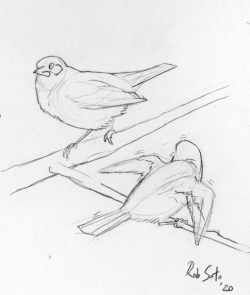![Click for a larger view: Bird Landing Courtesy & © Rob Soto, Artist A Pretty Decent Salve: [Watching a] Bird Landing Courtesy & © Rob Soto, Artist](https://wildaboututah.org/wp-content/uploads/soto.rob_.copyright.wild_about_utah_2.250x249.jpg)
Courtesy & © Rob Soto, Artist
The small black bird flew in hot to the powerline that runs next to my house, and came in just a bit too low. He couldn’t recover his trajectory, and instead of giving up, chose to use the chin of his beak to hang on like a feathered J hook. He kept flapping to stay on the line, perhaps because he didn’t trust his balance, but eventually the effort was too much, and he let his beak slide off backwards, and flew on. The whole thing only lasted a few seconds. I can only assume he stuck his next landing attempt.

Courtesy & © Rob Soto, Artist
Whatever it was, I can’t say. What I can say is that it was funny. Now I’ll forever see birds differently, too, knowing that making the landing isn’t as unconscious as I once thought, and so I can watch a once-passive act with a bit more suspense for slapstick.
I saw another funny thing recently, too. It also involved birds seen from my home. What I know is that I was watching a dance, but I couldn’t for the life of me tell if it was a warning display, or a proposition gone poorly.
There is a small tribe of house sparrows that lives in some shrubs adjacent to my home. I was working out on my porch in the sunshine one day when I heard an unfamiliar song in a familiar voice. I looked up to the top of a dead crabapple tree and saw a male sparrow doing a funny little jig. He was orbiting a female sparrow also perched in the tree, hopping and spinning from branch to branch, singing his flittery song. His back was flat, perpendicular to whatever branch he was on, and his wings were held in L-shapes which ran parallel to his flat back. It reminded me of the robot somehow.
I know that some birds dance, but I never thought it of the sparrows I see everyday and had never seen dance before. I’ve probably seen thousands of those little guys, but none apparently as gregarious before with me in the audience. I don’t know if the male was brave, indifferent, or if I was just lucky and this sort of thing happens all the time. Either way, his dance looked beautifully silly. It made me laugh to imagine myself dancing like this in the future, and when people looked at me quizzically, I could just say that I learned it from a sparrow. I could imagine the puzzled faces, tilted heads, and eye rolls: my personal humor at their gentle confusion.
After a few short minutes, the female sparrow being danced at, who had the whole time remained on a single perch just watching perhaps as perplexed as I was, flew off. In the end, I guess it did not matter if the male was dancing as a warning of territorial infringement, or as a suggestion of spring tangos. Whether the male was successful or failed cannot be told. He was though, I’ll say, the best house sparrow I’ve ever seen dance. So there’s that.
In all, it’s been a good challenge for me to look for everyday things with a lighter touch. It’s also been good to take time to look at what’s here, to challenge myself to enjoy some sunshine moments, to drive myself to look at average birds with interest, to upset my assumptions and learn why they’re not so average after all.
In this time, where a lot of what we are all doing is looking to a brighter future, imagining going back to familiar ruts, I’ve at least found that there is something that brightens the present in challenging yourself to be present: to take a minute in the sunshine, to take a minute to watch a bird you’ve seen a thousand times, to still find good humor in a still good world. While everything isn’t perfect, and we may feel like that bird who missed the line, confused and in a panic to say the least from being in uncharted waters, having a little laugh and finding the buoyant joy inherent in the natural world that’s always been there, and can always be there, is a pretty decent salve. I recommend it.
I’m Patrick Kelly and I’m Wild About Utah.
Credits:
A Pretty Decent Salve
Images: Images Courtesy & Copyright Rob Soto, Artist, all rights reserved
Audio: Contains audio Courtesy & Copyright Kevin Colver
Text: Patrick Kelly, Director of Education, Stokes Nature Center, https://logannature.org
Included Links: Lyle Bingham, Webmaster, WildAboutUtah.org
Additional Reading
Kubota, Taylor, What makes birds so good at sticking their landings?, Stanford Engineering, Transportation & Robotics, Stanford University, August 09, 2019, https://engineering.stanford.edu/magazine/article/what-makes-birds-so-good-sticking-their-landings
Stokes Nature Center, https://logannature.org
